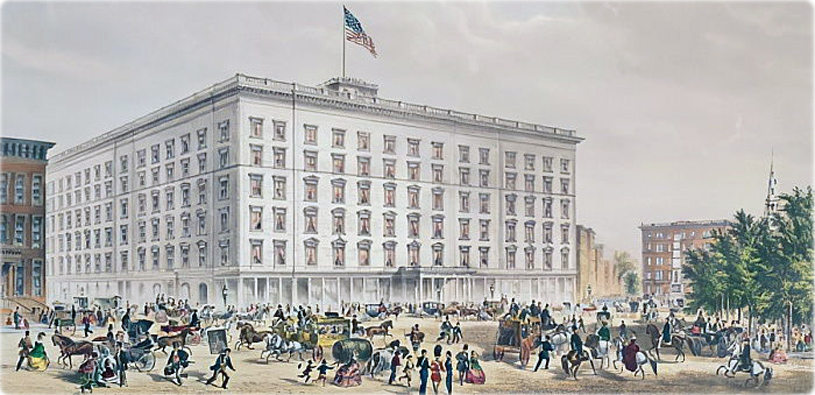
Fifth Avenue Hotel
The lost Fifth Avenue Hotel occupied the entire block on Fifth Avenue, between West 23rd and West 24th streets, facing Madison Square.
The site was previously occupied by Madison Cottage, which was removed in 1852 and succeeded, in 1853, by Franconi's Hippodrome. The location was then very far from the city center.
Later, the property was purchased by Amos Richards Eno (1810-1898), a real estate investor. Eno constructed some buildings in Fifth Avenue and Broadway, including the Madison Square Theatre, in 1863, and the four-story house at 233 Fifth Avenue, between 26th and 27th streets, that served as his residence for many years, today home of the Museum of Sex.
In June 1856, Eno began the construction of a hotel on the site of the old Hippodrome. Its completion was obstructed by the financial panic of 1857 and because the builder took a long time to find a lessee to his mind. By September, 1858, Paran Stevens (1802-1872), a hotelier of Boston, leased the future hotel, with permission to remodel the whole interior according to his own notions.
This six-story luxury hotel was designed by Griffith Thomas with William Washburn. It was at first called the Mount Vernon Hotel, as recorded on a contemporary map. The building was of a plain Italianate palazzo-front design, with a projecting tin cornice, sober exterior and portico with Corinthian columns. The interior was decorated with gilt wood, rich crimson or green curtains, rich carpets, handsome rose-wood and brocatelle suits. The floor of the entrance hall were of marble, laid in alternate blocks of dark red and white. There were five public entrances to the hotel, three in front and one in each side.
In 1859, the immense structure of white marble opened to the public on August 23, managed by Hitchcock, Darling & Co.
The Fifth Avenue Hotel was the first hotel in the United Stated to have installed a passenger elevator. It offered private bathrooms and fireplace in every room and employed about 400 servants to serve its guests.
The hotel attracted notable guests with its opulent dining room, private bathrooms, and fireplaces in every room. Ten presidents and several members of the British royalty stayed in the hotel.
Dunlap & Co. Hatters opened a store in ground floor of the hotel by September, 1859. When the lease expired by April 1871, the company announced their removal to a larger store at 174 Fifth Avenue. The place was then occupied by the Knox the Hatter. The store was still open in May 1908, after demolition work began on the building, a few weeks before.
The sidewalk clock near the main entrance was built by Seth Thomas Clock and installed before 1864. It was replaced by the Hecla Iron Works, installed in 1909. Sometime between 1899 and 1903, external fire escapes were installed in the hotel.
On December 11, 1872, a fire broke out in the Fifth Avenue Hotel, killing 15 employees.
The Fifth Avenue Hotel closed at midnight on April 4, 1908. The furniture and equipment were auctioned on April 7, by the proprietors Hitchcock, Darling & Co. Then the building was demolished. The site was occupied by the Fifth Avenue Building, an office building completed in 1909.

Fifth Avenue Hotel in 1859. Lithograph by John Henry Bufford (1810-1870), New-York Historical Society.
Fifth Avenue Hotel
|
Copyright © Geographic Guide - Old NYC. Historic Buildings. |
